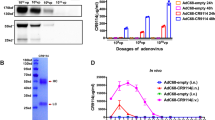Abstract
Animal models and phase I clinical trials have shown that repeat virus delivery and subsequent transgene expression is limited by the generation of humoral and cellular immune responses directed towards the therapeutic vector. The presence of a pre-existing immune response may even prevent initial delivery. In order to determine the presence of pre-existing anti-adenovirus humoral immunity we analysed ascitic fluid, collected from the peritoneal cavity of patients with advanced ovarian cancer. Twelve ascitic fluid and four matched serum samples were examined. The titre and isotype of anti-adenovirus antibodies was determined by ELISA, and Western blotting identified the molecular basis of the immune response, which was primarily directed towards fibre and penton base. Neutralisation of virus infectivity was assessed in vitro by measurement of green fluorescent protein reporter gene expression. We found that the ascitic fluid samples contain antibodies that recognise both adenovirus types 2 and 5, were predominantly IgG and directed towards the viral antigens responsible for cell adhesion, and had virus neutralising activity.
This is a preview of subscription content, access via your institution
Access options
Subscribe to this journal
Receive 12 print issues and online access
$259.00 per year
only $21.58 per issue
Buy this article
- Purchase on Springer Link
- Instant access to full article PDF
Prices may be subject to local taxes which are calculated during checkout






Similar content being viewed by others
References
Searle P, Mautner V . Adenoviral vectors: not to be sneezed at Gene Therapy 1998 5: 725–727
Zhang W . Development and application of adenoviral vectors for gene therapy of cancer Cancer Gene Therapy 1999 6: 113–138
Runyon BA . Editorial: malignancy-related ascites and ascitic fluid ‘Humoral tests of malignancy’ J Clin Gastroenterol 1994 18: 94–98
Puls LE et al. The prognostic implication of ascites in advanced-stage ovarian cancer Gynecol Oncol 1996 61: 109–112
Nagy JA, Herzberg KT, Dvorak JM, Dvorak HF . Pathogenesis of malignant ascites formation: initiating events that lead to fluid accumulation Cancer Res 1993 53: 2631–2643
Horwitz MS . Adenoviruses In: Fields BN et al (eds) Virology Lippincott-Raven: Philadelphia 1996 2149–2169
Shenk T . Adenoviridae: The viruses and their replication In: Fields BN et al (eds) Virology Lippincott-Raven: Philadelphia 1996 2111–2148
Crawford-Miksza L, Schnurr DP . Analysis of 15 adenovirus hexon proteins reveals the location and structure of seven hypervariable regions containing serotype-specific residues J Virol 1996 70: 1836–18445
Toogood CI, Crompton J, Hay RT . Antipeptide antisera define neutralizing epitopes on the adenovirus hexon J Gen Virol 1992 73: 1429–1433
Yang Y, Li Q, Ertl HCJ, Wilson JM . Cellular and humoral immune responses to viral antigens created barriers to lung-directed gene therapy with recombinant adenoviruses J Virol 1995 69: 2004–2015
Yang Y, Ertl HCJ, Wilson JM . MHC class I-restricted cytotoxic T lymphocytes to viral antigens destroy hepatocytes in mice infected with E1-deleted recombinant adenoviruses Immunity 1994 1: 433–442
Van Ginkel FW et al. Adenoviral gene delivery elicits distinct pulmonary-associated T helper cell responses to the vector and to its transgene J Immunol 1997 159: 685–693
Michou AI et al. Adenovirus-mediated gene transfer: influence of transgene, mouse strain and type of immune response on persistence of transgene expression Gene Therapy 1997 4: 473–482
Wilson JM . Vehicles for gene therapy Nature 1993 365: 691–692
Molnar-Kimber KL et al. Impact of pre-existing and induced humoral and cellular immune responses in an adenovirus-based gene therapy phase I clinical trial for localized mesothelioma Hum Gene Ther 1998 9: 2121–2133
Chirmule N et al. Immune responses to adenovirus and adeno-associated virus in humans Gene Therapy 1999 6: 1574–1583
Bastian A, Bewig B . Inhibition of adenovirus-mediated gene transfer by bronchoalveolar lavage fluid Gene Therapy 1999 6: 637–642
Harvey BG et al. Variability of human systemic humoral immune responses to adenovirus gene transfer vectors administered to different organs J Virol 1999 73: 6729–6742
Gahery-Segard H et al. Immune response to recombinant capsid proteins of adenovirus in humans: antifiber and anti-penton base antibodies have a synergistic effect on neutralizing activity J Virol 1998 72: 2388–2397
Wohlfart C . Neutralisation of adenoviruses: kinetics, stoichiometry, and mechanisms J Virol 1988 62: 2321–2328
Mastrangeli A et al. ‘Sero-switch’ adenovirus-mediated in vivo gene transfer: circumvention of anti-adenovirus humoral immune defenses against repeat adenovirus vector administration by changing the adenovirus serotype Hum Gene Ther 1996 7: 79–87
Roy S, Shirley PS, McClelland A, Kaleko M . Circumvention of immunity to the adenovirus major coat protein hexon J Virol 1998 72: 6875–6879
Fallaux FJ et al. Characterization of 911: a new helper cell line for the titration and propagation of early region 1-deleted adenoviral vectors Hum Gene Ther 1996 7: 215–222
Mautner V . Methods for growth and purification of enteric adenovirus type 40. In: Wold WSM (ed) Adenovirus Methods and Protocols Humana Press: New Jersey 1999 283–294
Lemay P, Boudin M, Milleville M, Boulanger P . Human adenovirus type 2 protein IIIa.I. Purification and characterisation Virology 1980 101: 131–143
Acknowledgements
We would like to thank Drs Moira Gilligan and Rachael Barton for the collection of ascitic fluid and serum samples and Dr Peter Searle for construction of Ad-CMV-gfpΔE1. We are indebted to Dr Leonard Seymour for stimulating discussions and critical reading of the manuscript. This work was supported by the Cancer Research Campaign and the Medical Research Council.
Author information
Authors and Affiliations
Rights and permissions
About this article
Cite this article
Stallwood, Y., Fisher, K., Gallimore, P. et al. Neutralisation of adenovirus infectivity by ascitic fluid from ovarian cancer patients. Gene Ther 7, 637–643 (2000). https://doi.org/10.1038/sj.gt.3301152
Received:
Accepted:
Published:
Issue Date:
DOI: https://doi.org/10.1038/sj.gt.3301152



